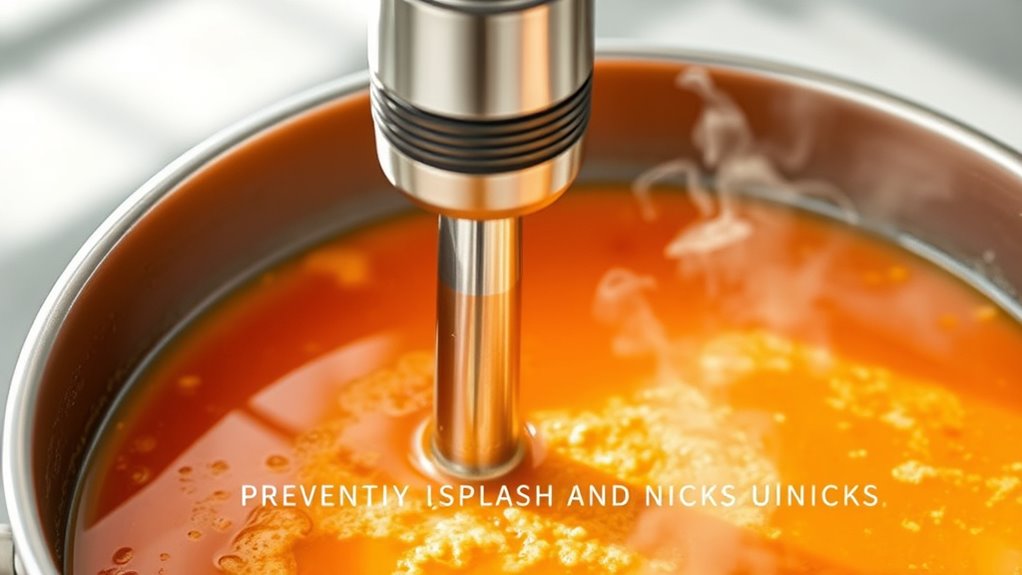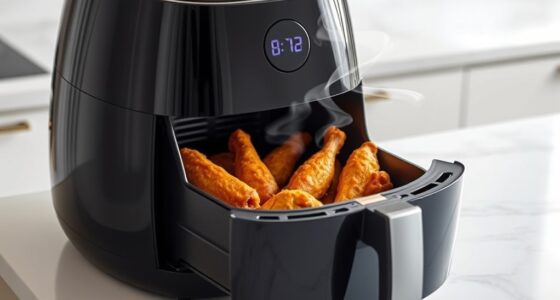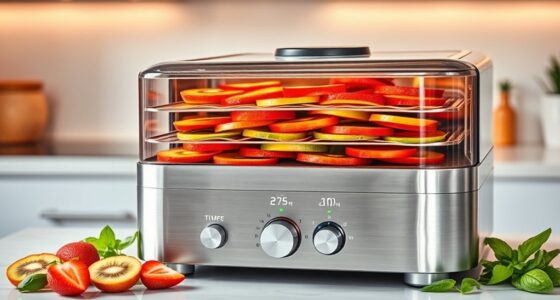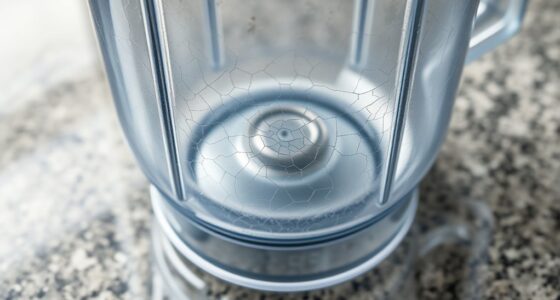To avoid splash burns and nicks with your immersion blender, choose a model with sharp blades and adjustable speeds for better control. Always fully submerge the blades before turning it on and keep your hands away from moving parts. Use protective gloves when handling hot liquids, and prepare ingredients by cutting them into small pieces. Regularly maintain and clean your device to prevent malfunctions. Following these tips helps keep your blending safe—if you continue exploring, you’ll discover more essential safety steps.
Key Takeaways
- Fully submerge the blades before turning on to prevent splashes and spills.
- Use low or medium speed settings for better control and reduced splatter.
- Keep blades away from skin and handle the device firmly during operation.
- Wear protective gloves or sleeves to shield hands from splashes and accidental nicks.
- Regularly inspect and maintain blades and cord to prevent malfunctions and injuries.
Choosing the Right Equipment for Safe Blending
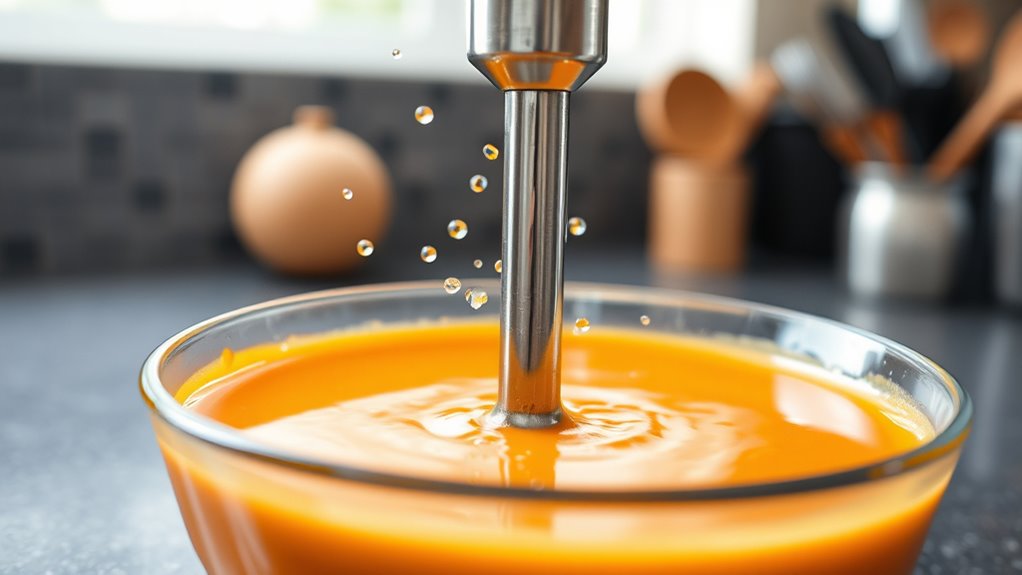
Choosing the right equipment is essential for safe blending with an immersion blender. Start by checking the blade sharpness; dull blades require more force, increasing the risk of splashes and accidents. Sharp blades cut through ingredients smoothly, reducing the chance of slips that could lead to burns or nicks. Next, consider the power settings. A model with adjustable speed allows you to control blending intensity, helping you avoid splattering hot liquids or dense ingredients. Lower settings are ideal for delicate tasks, while higher ones handle tougher textures. Selecting an immersion blender with appropriate blade sharpness and versatile power settings guarantees safer operation, minimizes splashing, and gives you better control during use. Proper equipment choice is your first step toward safe, efficient blending. AI-driven solutions are increasingly being incorporated into kitchen appliances, enhancing safety and precision during food preparation.
Preparing Your Ingredients to Minimize Splashing
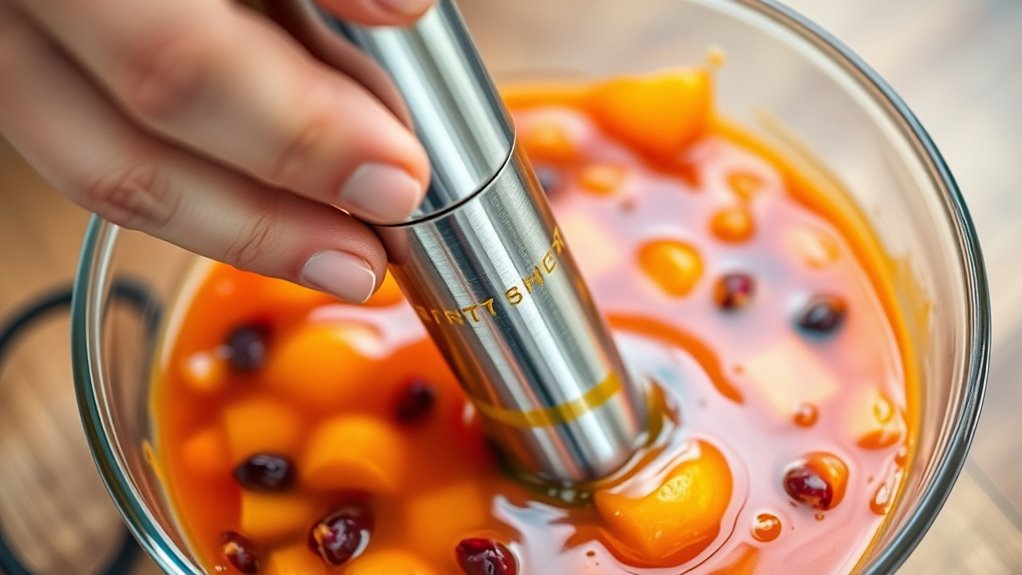
To minimize splashing when using your immersion blender, it’s important to prepare your ingredients properly before blending. Start by cutting ingredients into smaller, uniform pieces to aid smooth blending and reduce sudden splashes. Keep liquids at a manageable level—filling your container no more than halfway helps prevent overflow. Use dry ingredients first or add liquids gradually to avoid sudden splashes caused by rapid immersion. Thick or frozen ingredients can cause splatter, so thaw or soften them beforehand. Proper ingredient preparation is key to splash prevention, making your blending safer and cleaner. Additionally, understanding the optimal angles for pinball machines can improve your control and safety during operation. By taking these simple steps, you reduce the risk of splashing and ensure a more controlled, efficient blending process.
Proper Technique for Using an Immersion Blender
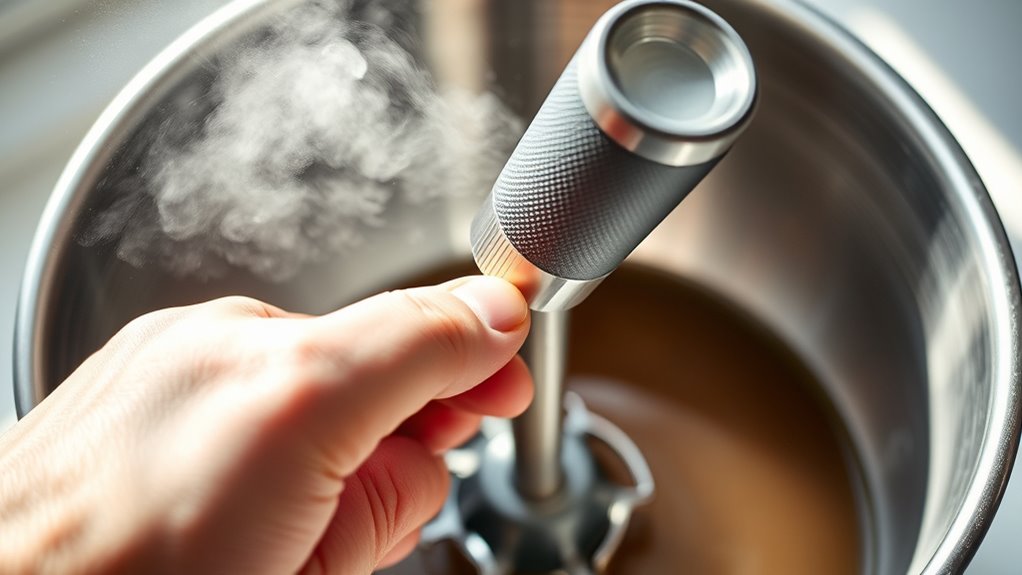
To use your immersion blender safely, you need to master a few key techniques. Keep a steady grip and fully submerge the blender before turning it on to avoid splashes. Always keep the blades away from your skin to prevent injuries and make sure effective blending. Additionally, understanding the importance of proper technique can help prevent common accidents and ensure optimal performance.
Maintain a Steady Grip
Maintaining a steady grip on your immersion blender is essential for safe and effective blending. You should focus on maintaining a firm grip to prevent slips that could cause splashes or injuries. Proper hand positioning ensures better control and reduces fatigue during prolonged use. Keep your hands close to the motor housing, with your fingers wrapped securely around the handle. Avoid gripping too tightly, which can cause fatigue, but ensure enough firmness to keep the blender stable. Use your dominant hand for better control, and support the blender with your other hand if needed for added stability. Consistent grip firmness and correct hand positioning allow you to maneuver smoothly, preventing accidents and ensuring your mixture stays contained. Additionally, understanding the mechanics of pinball machines can help you appreciate how mechanical control contributes to safety and performance in various devices.
Submerge Fully Before Blending
Make certain the immersion blender’s blades are fully submerged before you start blending. This prevents splashing and reduces the risk of splash burns. Before turning on the blender, adjust the blender speed settings to a low or medium level, especially if you’re new to using it. Once the blades are submerged, you can gradually increase the speed as needed. Keep the cord managed to avoid accidental pulls or tangling, which can cause spills or injuries. Always hold the blender steady and maintain full control during operation. Submerging completely guarantees efficient blending and minimizes splatter. Remember, rushing or using high speeds too soon can be messy and unsafe. Proper technique makes blending safer, cleaner, and more effective. Being mindful of your workspace helps prevent accidents and keeps your environment organized during use.
Keep Blades Away From Skin
Always keep the blades of your immersion blender away from your skin to prevent cuts and injuries. Proper blade safety is essential to avoid nicks and accidental cuts. When blending, hold the device firmly and maintain control, ensuring the blades stay submerged and away from your body. Keep your hands and fingers clear of the blade’s path at all times. Never press the blender too close to your skin, even if you’re trying to stabilize it. Remember, skin protection relies on maintaining a safe distance from the blades. If you need to adjust the position, turn off the appliance first. Staying vigilant about blade safety helps prevent injuries and keeps your kitchen experience safe and efficient. Additionally, understanding dog names can sometimes help in creating a personalized safety routine by using familiar terms to remind yourself of safety protocols.
Protecting Your Hands and Skin During Operation
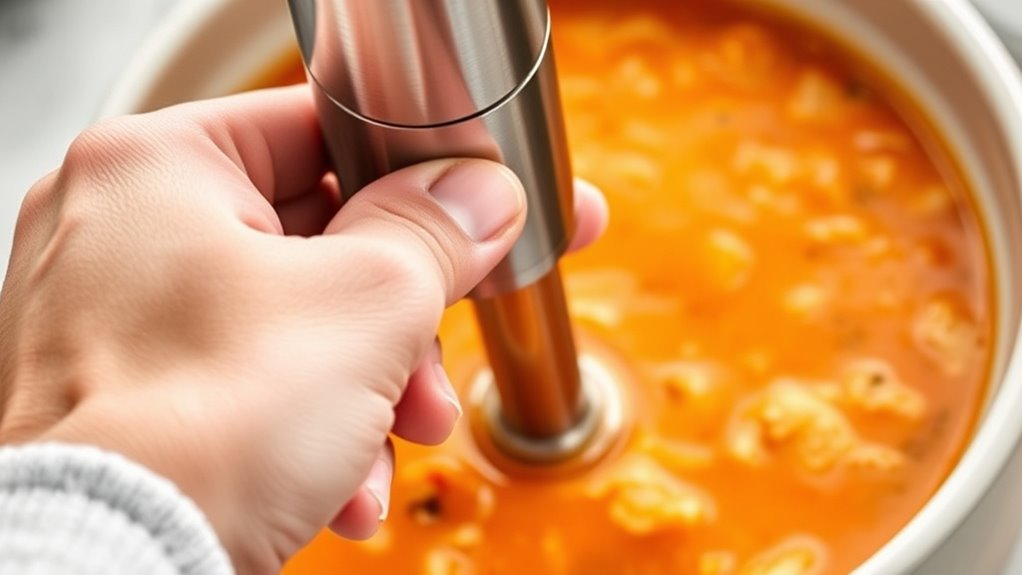
To avoid injuries while using an immersion blender, you need to be mindful of protecting your hands and skin during operation. Always wear gloves or use a protective sleeve to prevent accidental splashes or nicks. Keep your hands away from the blades and hot liquids to maintain skin safety. Use a firm grip on the blender handle to control movement and avoid slips that could cause injury. Additionally, being aware of electric power generation principles can help you understand how to operate the blender more efficiently and safely.
Cleaning and Maintenance to Prevent Accidents

Regularly cleaning and maintaining your immersion blender is essential for preventing accidents. After each use, wash the blade thoroughly to remove food residue, which can cause nicks or dullness that increase the risk of splashes or injuries. Sharpen the blade periodically to guarantee it cuts smoothly, reducing the chance of slipping during operation. Additionally, check the motor’s maintenance—wipe the motor housing to prevent dust buildup and ensure it runs efficiently. Avoid immersing the motor in water, which can cause electrical hazards. Keep the blade attachment secure and free of corrosion. Proper cleaning reduces the likelihood of malfunction, splashes, or unexpected stops that could lead to injuries. Regular equipment inspection can help identify potential issues early and maintain optimal safety. Consistent maintenance keeps your immersion blender safe, reliable, and in prime condition.
Troubleshooting Common Issues Safely

When your immersion blender starts to malfunction, addressing issues promptly and safely can prevent further damage or injury. Follow these steps to troubleshoot safely and maintain blender safety:
- Unplug the blender immediately to prevent accidental operation.
- Check for loose or damaged blades—replace if necessary.
- Inspect the cord for wear or frays, and avoid using if damaged.
- Clear any stuck food or debris from the blade area before attempting repairs.
- Refer to manufacturer guidelines for proper maintenance to ensure safe and effective operation.
Always prioritize accident prevention by avoiding contact with moving parts and handling the device carefully. If you’re unsure about fixing a problem, consult the manufacturer’s instructions or seek professional repair. Remember, safe troubleshooting keeps your kitchen safe and extends your blender’s lifespan. Proper care and quick action help you avoid splashes, burns, and nicks.
Tips for Safe Storage and Handling
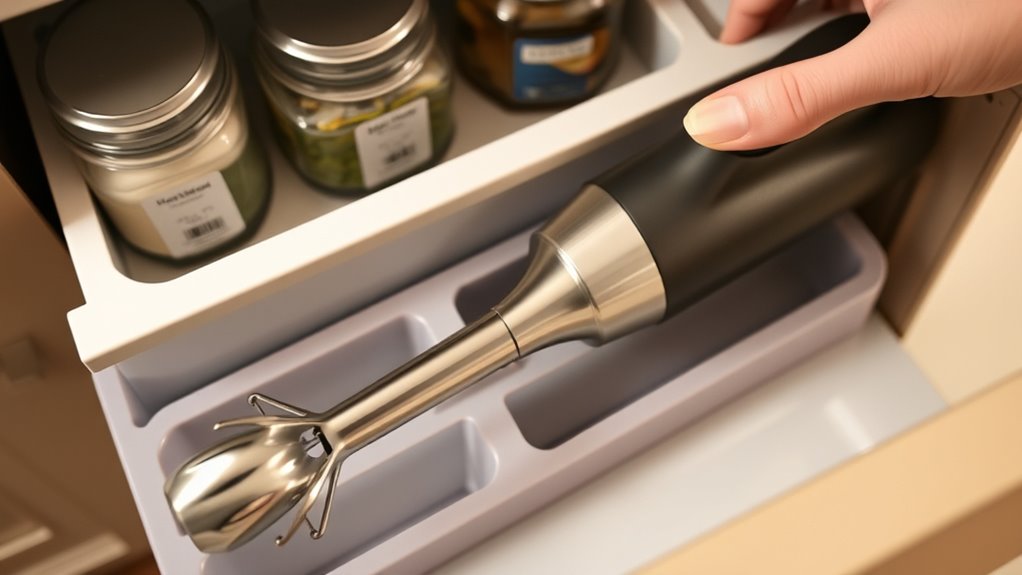
Proper storage and handling are essential for keeping your immersion blender safe and in good working condition. To ensure longevity, always store your blender in a dry, secure place away from children and pets. Use storage tips like hanging it on a hook or keeping it in a dedicated drawer to prevent accidental damage. When handling your immersion blender, take handling precautions by unplugging it before cleaning or changing attachments. Keep the cord untangled and avoid wrapping it tightly around the motor to prevent damage. Never immerse the motor housing in water, and always dry it thoroughly after cleaning. Following these storage tips and handling precautions will reduce the risk of accidents, prolong your blender’s life, and ensure safe operation every time. Additionally, regularly inspecting your blender for signs of wear can help prevent malfunctions and maintain optimal performance.
Frequently Asked Questions
Can Using an Immersion Blender Cause Allergic Reactions?
Using an immersion blender can cause allergic reactions if you’re sensitive to certain ingredients you’re blending. If you have ingredient sensitivities, tiny particles or residues might trigger allergic responses. Always guarantee ingredients are safe for you, and clean your blender thoroughly after each use. If you notice symptoms like itching or swelling, stop using it immediately and consult a healthcare professional. Being cautious helps prevent allergic reactions when using an immersion blender.
What Should I Do if I Accidentally Cut Myself?
Did you know that about 5 million people seek emergency care for cuts each year? If you accidentally cut yourself, immediately stop using the immersion blender. First aid procedures include cleaning the wound gently with soap and water to prevent infection, then applying pressure to stop bleeding. Cover it with a sterile bandage and keep it elevated. Seek medical attention if the cut is deep, won’t stop bleeding, or shows signs of infection.
Are There Specific Safety Certifications to Look For?
You should look for immersion blenders with certification standards and safety marks like UL, CE, or NSF. These certifications guarantee the product meets strict safety and quality requirements. When you see these marks, you can trust the device has been tested for electrical safety, durability, and safe operation. Always check for proper certification before purchasing or using an immersion blender to minimize risks and ensure safe usage.
How Do I Prevent Cross-Contamination When Blending Different Foods?
Worried about cross-contamination when blending different foods? You can prevent it by following proper cleaning procedures and storing your immersion blender correctly. After each use, thoroughly wash the blending shaft with hot, soapy water, making sure to clean any crevices. Store your blender in a clean, dry place away from raw foods. Do you regularly sanitize your equipment? Proper food storage and cleaning keep your kitchen safe and hygienic.
Is It Safe to Blend Hot Liquids Directly in the Pot?
Yes, it’s safe to blend hot liquids directly in the pot if you follow hot liquid safety tips. Let the liquid cool slightly and fill the blender halfway to prevent splashing. Keep the immersion blender submerged and hold it steady while blending. Use gentle, pulsing motions and don’t cover the top tightly to avoid pressure buildup. These immersion blender tips help you blend hot liquids safely and efficiently.
Conclusion
By following these safety tips, you can enjoy the convenience of your immersion blender without risking splash burns or nicks. Think of it as your trusty Excalibur—powerful yet requiring respect and care. Always stay attentive, prep properly, and handle your equipment with caution. With a little mindfulness, you’ll blend with confidence, turning your kitchen into a safe haven. Remember, safety isn’t just a modern trend; it’s the key to creating culinary magic without mishaps.
